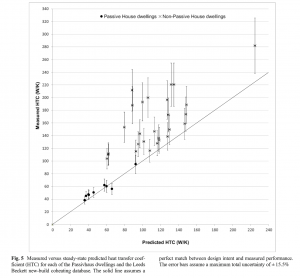I’m sometime asked just how accurate PHPP’s models are. This great paper quantifies it.
“Are the energy savings of the passive house standard reliable? A review of the as-built thermal and space heating performance of passive house dwellings from 1990 to 2018.” David Johnston, Mark Siddall, Oliver Ottinger, Soeren Peper and Wolfgang Feist
When measured in the real world, the accuracy of predictions made by PHPP for certified Passive House buildings can be +/- 20% for space heating demand. That seems a lot, but in absolute terms, it’s tiny, as it’s 20% of 15kW for every square metre of floor space, not 150kW. This degree of accuracy assumes you had good climate data and knew how the occupant/s will behave when you did the model. Obviously, if next winter is 30% warmer than last year, the figures would be off more than 20%.
I am reminded of a (true) story about a comparison made between a Code minimum home and a high-performance home in Boston. The two buildings were otherwise the same. The results were nuts: where were the promised energy savings in the high-performance home? Only further investigation uncovered that its tenant was leaving the door open all day—through a Massachusetts winter!—so her dog could amble in and out at his leisure. She loved that her heat pump could still keep her home toasty warm.
The paper went on to rather dryly point out: “It has to be stated that the estimated uncertainty for the space heating demand is the best possible value. An individual measured space heating energy consumption can have much larger variances than the derived ± 3 kWh/(m2a).”
The variation of climate from standard and occupant behaviour is important in any specific year and building, but not on average.
The abstract is available online here. At least read the abstract. This figure is from the paper:

—Jason Quinn
15 June 2020